Wikipedia:Picture of the day/July 2017
|
Featured picture tools: |
These featured pictures, as scheduled below, appeared as the picture of the day (POTD) on the English Wikipedia's Main Page in July 2017. Individual sections for each day on this page can be linked to with the day number as the anchor name (e.g. [[Wikipedia:Picture of the day/July 2017#1]] for July 1).
You can add an automatically updating POTD template to your user page using {{Pic of the day}} (version with blurb) or {{POTD}} (version without blurb). For instructions on how to make custom POTD layouts, see Wikipedia:Picture of the day.Purge server cache
July 1
Subpage 1
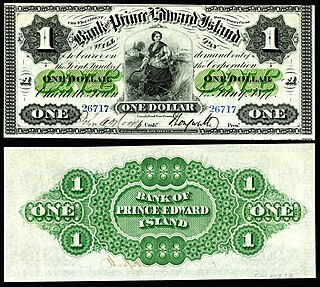
|
A banknote in the denomination of one Prince Edward Island dollar. This dollar was introduced in Prince Edward Island (PEI) in 1872, when it was a British colony, by the Bank of PEI. It replaced the PEI pound at a rate of 1 pound to 4.866 dollars. Although PEI joined Canada in 1873, its dollar was reissued once before being absorbed into the Canadian dollar. Banknote: British American Banknote Company (image courtesy of the National Numismatic Collection, National Museum of American History)
Recently featured:
|
Subpage 2

|
A banknote in the denomination of two Prince Edward Island dollars. This dollar was introduced in Prince Edward Island (PEI) in 1872, when it was a British colony, by the Bank of PEI. It replaced the PEI pound at a rate of 1 pound to 4.866 dollars. Although PEI joined Canada in 1873, its dollar was reissued once before being absorbed into the Canadian dollar. Banknote: British American Banknote Company (image courtesy of the National Numismatic Collection, National Museum of American History)
Recently featured:
|
Subpage 3

|
A banknote in the denomination of five Prince Edward Island dollars. This dollar was introduced in Prince Edward Island (PEI) in 1872, when it was a British colony, by the Bank of PEI. It replaced the PEI pound at a rate of 1 pound to 4.866 dollars. Although PEI joined Canada in 1873, its dollar was reissued once before being absorbed into the Canadian dollar. Banknote: British American Banknote Company (image courtesy of the National Numismatic Collection, National Museum of American History)
Recently featured:
|
Subpage 4

|
A banknote in the denomination of ten Prince Edward Island dollars. Introduced in 1872 by the Bank of Prince Edward Island, this dollar circulated in the then-British colony of Prince Edward Island. It replaced the pound at a rate of 1 pound to 4.866 dollars. Although Prince Edward Island joined the Canadian Confederation in 1873, its dollar was reissued once before being absorbed into the Canadian dollar. Banknote: British American Banknote Company (image courtesy of the National Numismatic Collection, National Museum of American History)
Recently featured:
|
Subpage 5

|
A banknote in the denomination of twenty Prince Edward Island dollars. This dollar was introduced in Prince Edward Island (PEI) in 1872, when it was a British colony, by the Bank of PEI. It replaced the PEI pound at a rate of 1 pound to 4.866 dollars. Although PEI joined Canada in 1873, its dollar was reissued once before being absorbed into the Canadian dollar. Banknote: British American Banknote Company (image courtesy of the National Numismatic Collection, National Museum of American History)
Recently featured:
|
July 2

|
Augustus Brine (1769–1840) as a midshipman in 1782. The son of Admiral James Brine, he joined the Royal Navy at age 13 and served on his father's ship during the American War of Independence. He was commissioned a lieutenant in 1790 and took his first command during the French Revolutionary Wars. Promoted to commander in 1798, he served at the Cape of Good Hope by 1798. His final combat engagement was in the Napoleonic Wars, when he commanded HMS Medway as flag captain to Vice-Admiral Charles Tyler. Painting: John Singleton Copley
Recently featured:
|
July 3

|
A rough chameleon (Trioceros rudis) near Mount Karisimbi, an inactive volcano in the Virunga Mountains in Rwanda. This specimen measures approximately 12 cm (4.7 in) long. Chameleons change color by changing the space between crystals in their skin, which changes the wavelength of light they reflect. Photograph: Charles J. Sharp
Recently featured:
|
July 4

|
The title page to State Arms of the Union, a book illustrated by Henry Mitchell and published by Louis Prang that shows historically accurate renderings of coats of arms of the U.S. states from 1876. Designs of state coats of arms or seals have generally been authorized by a provision in the state constitution or a legislative act. An impression of the Great Seal of a state (or its coat of arms) has long been required on official documents, as this is the emblem that certifies the authenticity of a given document or that the authority of the state is invested in said document. Illustration: Henry Mitchell; restoration: Andrew Shiva
Recently featured:
|
July 5

|
Jean Cocteau (1889–1963) was a French writer, designer, playwright, artist and filmmaker. He is best known for his novel Les Enfants Terribles (1929), as well as the films The Blood of a Poet (1930), Les Parents Terribles (1948), Beauty and the Beast (1946) and Orpheus (1949). Photograph: Agence de presse Meurisse; restoration: JLPC
Recently featured:
|
July 6

|
Banyunibo is a 9th-century Buddhist temple located in Sleman Regency, Indonesia. The temple, dating from the era of Medang Kingdom, sits in a narrow valley surrounded by paddy fields about two kilometers southeast of the Ratu Boko archaeological park. Its curved rooftop design, crowned with a solitary stupa, is unique among the surviving Buddhist temples of Central Java. Photograph: Chris Woodrich
Recently featured:
|
July 7

|
Portrait of a Carthusian is a painting in oils on oak panel completed by the Early Netherlandish painter Petrus Christus in 1446. It is a three-quarter portrait of anonymous Carthusian monk gazing directly at the viewer. Towards the bottom of the painting is a trompe l’oeil fly, making it an early example of the technique. Regarded as a masterpiece of Early Netherlandish painting, it is held by the Metropolitan Museum of Art in New York City. Painting: Petrus Christus
Recently featured:
|
July 8
Subpage 1

|
The interior of the chapel at Selwyn College, Cambridge, looking towards the altar. Selwyn College was established in 1882 with the mission of making "provision for those who intend to serve as missionaries overseas and... educate the sons of clergymen". Membership was initially limited to baptised Christians, and attendance at the chapel – which was built in 1895 – was mandatory until 1935. Photograph: David Iliff
Recently featured:
|
Subpage 2

|
The interior of the chapel at Selwyn College, Cambridge, looking towards the entrance and choir. Selwyn College was established in 1882 with the mission of making "provision for those who intend to serve as missionaries overseas and... educate the sons of clergymen". Membership was initially limited to baptised Christians, and attendance at the chapel – which was built in 1895 – was mandatory until 1935. Photograph: David Iliff
Recently featured:
|
July 9

|
Assembly of the North American B-25 Mitchell in Kansas City, Kansas, in 1942. This twin-engine medium bomber was manufactured by North American Aviation and named in honor of Major General William Mitchell, a pioneer of U.S. military aviation. Used by many Allied air forces, the B-25 served in every theater of World War II. Many remained in service in the decades after the war. Nearly 10,000 Mitchells rolled from NAA factories, including limited models for the U.S. Marine Corps and Army Air Forces. Photograph: Alfred T. Palmer; restoration: Adam Cuerden
Recently featured:
|
July 10

|
A small heath (Coenonympha pamphilus) butterfly in Kampinos National Park near Warsaw in Poland. This species belongs to the family Nymphalidae. It is widespread in Eurasia and north-western Africa, preferring drier habitats than other members of its genus. Photograph: Charles J. Sharp |
July 11

|
Dovedale by Moonlight is an oil painting on canvas completed by Joseph Wright of Derby in 1785. One of five paintings by the artist that uses the picturesque valley of Dovedale as its subject, it was not painted directly but using a mixture of studies and chance. The painting is held by the Allen Memorial Art Museum at Oberlin College, Ohio. Painting: Joseph Wright of Derby
Recently featured:
|
July 12

|
The constellation Virgo ('the virgin') as depicted in Urania's Mirror, a set of constellation cards published in London c. 1825. Virgo is one of the twelve constellations of the zodiac, and the second largest of the 88 modern constellations. Aside from its brightest star, Spica, the constellation also contains the quasar 3C 273 (the first quasar discovered) and several galaxy clusters. Illustration: Sidney Hall; restoration: Adam Cuerden
Recently featured:
|
July 13

|
The Kodiak bear (Ursus arctos middendorffi) is a subspecies of brown bear that inhabits the islands of the Kodiak Archipelago in southwest Alaska. One of the largest bears alive today, it commonly reaches sizes of 300 to 600 kg (660 to 1,300 lb). Its diet, lifestyle, and physiology are similar to other brown bear subspecies, such as the mainland grizzly and the now-extinct California grizzly bear. Photograph: Yathin S Krishnappa
Recently featured:
|
July 14

|
The crowns of Silla are a series of gold crowns made in the Korean kingdom of Silla between the 5th and 7th centuries CE. These crowns were excavated in Gyeongju, the former capital of Silla. All are designated national treasures of South Korea. Shown here is the gold crown from Seobongchong Tumulus (Treasure No. 339), an ornamented crown with five branches standing on the broad crown frame. It is held by the Gyeongju National Museum. Photograph: National Museum of Korea
Recently featured:
|
July 15

|
The SG-1000 is a cartridge-based home video game console manufactured by Sega. Introduced in 1983, it was developed in response to a downturn in arcades in 1982. Its game library comprises 68 standard cartridge releases and 29 Sega Card releases. The SG-1000 made little impact in the video game industry, but provided the basis for the more successful Master System in 1985. Photograph: Evan Amos
Recently featured:
|
July 16

|
The Plumb-pudding in danger (1805), an editorial cartoon by James Gillray showing the world being carved up into spheres of influence between William Pitt and Napoleon. It caricatures overtures made by Napoleon in January 1805 for a reconciliation with Britain during the War of the Third Coalition. Martin Rowson deems it "probably the most famous political cartoon of all time – it has been stolen over and over and over again by cartoonists ever since." Illustration: James Gillray
Recently featured:
|
July 17
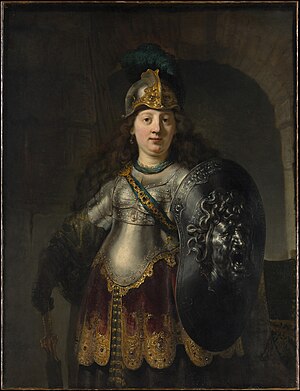
|
Bellona was an Ancient Roman goddess of war, corresponding to the Ancient Greek Enyo. She was called the sister of Mars, and in some sources, his wife or an associate of his female cult partner Nerio. This painting of the goddess is attributed to Rembrandt and was completed in 1633. It is held at the Metropolitan Museum of Art in New York. Painting: Rembrandt
Recently featured:
|
July 18

|
Red Skelton (1913–1997) was an American entertainer. He was best known for his national radio and television acts between 1937 and 1971, and as host of the television program The Red Skelton Show. Skelton also appeared in burlesque, vaudeville, films, nightclubs, and casinos. He has stars on the Hollywood Walk of Fame for his work in radio and television, and many of his personal and professional effects are part of the Red Skelton Museum of American Comedy at Vincennes University in Indiana. Photograph: Unknown; restoration: Adam Cuerden
Recently featured:
|
July 19
Subpage 1

|
A half-shilling note of the Japanese government-issued Oceanian Pound. This currency was issued during World War II by the Empire of Japan to replace local hard currencies in occupied Oceania, consisting of Guam, Gilbert and Ellice Islands, Caroline Islands, Marianas Islands, Solomon Islands, Palau, and the now-defunct Territory of New Guinea. Notes were printed before invasion and intended to circulate in multiple areas that were to be absorbed into the Greater East Asia Co-Prosperity Sphere. They include the title "The Japanese Government" and a "serial number" consisting of an "O" (indicating issue for Oceania) and a printing batch identifier. After the war, they could be exchanged for United States dollars or Australian pounds. Other notes: 1 shilling, 10 shillings, 1 pound Banknote: Empire of Japan (image courtesy of the National Numismatic Collection, National Museum of American History)
Recently featured:
|
Subpage 2
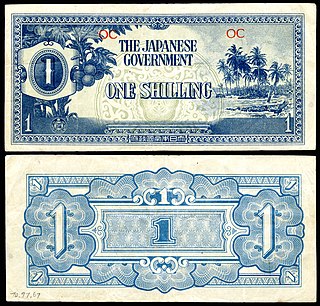
|
A one-shilling note of the Japanese government-issued Oceanian Pound. This currency was issued during World War II by the Empire of Japan to replace local hard currencies in occupied Oceania, consisting of Guam, Gilbert and Ellice Islands, Caroline Islands, Marianas Islands, Solomon Islands, Palau, and the now-defunct Territory of New Guinea. Notes were printed before invasion and intended to circulate in multiple areas that were to be absorbed into the Greater East Asia Co-Prosperity Sphere. They include the title "The Japanese Government" and a "serial number" consisting of an "O" (indicating issue for Oceania) and a printing batch identifier. After the war, they could be exchanged for United States dollars or Australian pounds. Other notes: half-shilling, 10 shillings, 1 pound Banknote: Empire of Japan (image courtesy of the National Numismatic Collection, National Museum of American History)
Recently featured:
|
Subpage 3

|
A ten-shilling note of the Japanese government-issued Oceanian Pound. This currency was issued during World War II by the Empire of Japan to replace local hard currencies in occupied Oceania, consisting of Guam, Gilbert and Ellice Islands, Caroline Islands, Marianas Islands, Solomon Islands, Palau, and the now-defunct Territory of New Guinea. Notes were printed before invasion and intended to circulate in multiple areas that were to be absorbed into the Greater East Asia Co-Prosperity Sphere. They include the title "The Japanese Government" and a "serial number" consisting of an "O" (indicating issue for Oceania) and a printing batch identifier. After the war, they could be exchanged for United States dollars or Australian pounds. Other notes: half-shilling, 1 shilling, 1 pound Banknote: Empire of Japan (image courtesy of the National Numismatic Collection, National Museum of American History)
Recently featured:
|
Subpage 4

|
A one-pound note of the Japanese government-issued Oceanian Pound. This currency was issued during World War II by the Empire of Japan to replace local hard currencies in occupied Oceania, consisting of Guam, Gilbert and Ellice Islands, Caroline Islands, Marianas Islands, Solomon Islands, Palau, and the now-defunct Territory of New Guinea. Notes were printed before invasion and intended to circulate in multiple areas that were to be absorbed into the Greater East Asia Co-Prosperity Sphere. They include the title "The Japanese Government" and a "serial number" consisting of an "O" (indicating issue for Oceania) and a printing batch identifier. After the war, they could be exchanged for United States dollars or Australian pounds. Other notes: half-shilling, 1 shilling, 10 shillings Banknote: Empire of Japan (image courtesy of the National Numismatic Collection, National Museum of American History)
Recently featured:
|
July 20

|
The domed ceiling of Sheikh Lotfollah Mosque, a 17th-century mosque located on the eastern side of Naqsh-e Jahan Square in Isfahan, Iran. The eight-fold symmetry of the dome's interior is created by rings of ornamental bands filled with arabesque patterns that become smaller and smaller towards the top. Such use of symmetry is common in Islamic architecture, which tends to emphasize aniconism through its use of geometric patterns and calligraphy. Photograph: Phillip Maiwald
Recently featured:
|
July 21

|
Apollo 11 was the spaceflight that landed the first two humans, commander Neil Armstrong and LM pilot Buzz Aldrin, on the Moon. On July 21, 1969, Armstrong became the first human to walk on the Moon. This mission quickly captured the public's imagination and became prominent in popular culture. Over 530 million viewers worldwide watched the Moon landing, and it received widespread newspaper coverage. For example, the July 21, 1969, edition of The Washington Post—shown here—used the main headline "'The Eagle Has Landed'—Two Men Walk on the Moon". In subsequent years, the Moon landing has been frequently depicted or referenced in media, including in literature, films, and video games. Photograph: Jack Weir; restoration: CarolSpears |
July 22

|
The Temptation of St. Anthony is a panel painting by Hieronymus Bosch or a follower. Completed c. 1500–1525, it depicts St. Anthony the Abbot in meditation, in a sunny landscape near the trunk of a dry tree. He is undisturbed by the demons surrounding him. The panel was held by the Escorial monastery, but is currently housed in the Museo del Prado in Madrid. Photograph: Hieronymus Bosch or a follower |
July 23
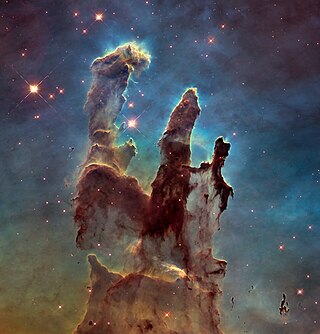
|
The Pillars of Creation, a series of elephant trunks of interstellar gas and dust in the Eagle Nebula, are the subject of a famous Hubble Space Telescope photograph taken in 1995. They are so named because the depicted gas and dust, while being eroded by the light from nearby stars, are in the process of creating new stars. Shown here is a 2014 rephotograph, which was unveiled in 2015 as part of the telescope's 25th anniversary celebrations. |
July 24
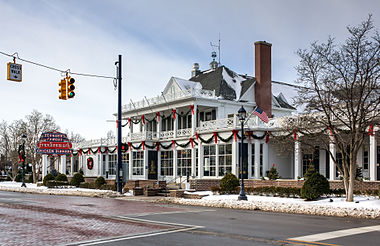
|
Zehnder's is a restaurant in Frankenmuth, Michigan, that serves American or midwestern-style food, including all-you-can-eat chicken dinners. Built in a former hotel, it has seating for 1,500 people and a total annual patronage of approximately a million people. In the 1980s, it was one of the ten largest restaurants in the United States. Photograph: Chris Woodrich
Recently featured:
|
July 25

|
Three Arch Bay is a 29-acre private gated community located at the southern end of Laguna Beach, California. It includes a house built by the director Edward H. Griffith and was the shooting location for Michael Curtiz' 1935 film Captain Blood. Photograph: D. Ramey Logan
Recently featured:
|
July 26

|
The Old Musician is an 1862 oil painting on canvas by the French painter Édouard Manet. Depicting an old musician with a violin surrounded by listeners, the painting has been seen as influenced by Spanish art and the work of Gustave Courbet. This work is one of Manet's largest paintings and is now held at the National Gallery of Art in Washington, D.C. Photograph: Édouard Manet
Recently featured:
|
July 27

|
A two-shilling note of the New York pound, a currency used in the Province of New York. Although the production of paper money had been prohibited by the Currency Act in 1764, partial permission for the issuance of banknotes in New York was granted in the early 1770s together with the repeal of the Townshend Acts. This note was signed by John Cruger Jr., then the speaker of the New York assembly. Banknote: Province of New York, printed by H. Gains (image courtesy of the National Numismatic Collection, National Museum of American History)
Recently featured:
|
July 28

|
Centaurea jacea is a species of herbaceous perennial plant in the genus Centaurea found in dry meadows and open woodland throughout Europe. It grows to 10–80 centimetres (4–31 in) tall, and flowers mainly from June to September. Photograph: Uoaei1
Recently featured:
|
July 29

|
Simeis 147, also known as the Spaghetti Nebula, is a supernova remnant (SNR) in the Milky Way. Straddling the border between the constellations Auriga and Taurus, the nebula was discovered in 1952 at the Crimean Astrophysical Observatory. It is difficult to observe due to its extremely low brightness. Photograph: Rogelio Bernal Andreo
Recently featured:
|
July 30

|
Cairn in Snow is a landscape painting by Caspar David Friedrich that was completed in 1807. The painting is a Romantic allegorical landscape, showing a pagan burial site between three oaks, near the town Gützkow in Germany. It is held by the Galerie Neue Meister in Dresden, Germany. Painting: Caspar David Friedrich
Recently featured:
|
July 31

|
|
A diagram showing the basic anatomy and arrangement of internal organs of the saltwater limpet Patella vulgata. Limpets are aquatic snails with shells that are broadly conical in shape, although the term also refers informally to all gastropods whose shells have no obvious coiling. Members of the family Patellidae, which includes the species shown, are often called the "true limpets" (as opposed to the false limpets and the keyhole limpets). All limpets use their muscular foot for movement and excrete mucus to apply suction and resist wave movement and predation. This image allows the viewer to see the neural torsion common to most snails, wherein the visceral nerves have become "twisted" causing the rectum and kidneys to open near the animal's head. This is the result of once having had an ancestor with a coiled shell— in limpets, the coiled shell has been replaced by a conical one, but the torsion in the Patellidae remains; some other gastropod groups have subsequently "detorted". Direction of blood flow is indicated in this diagram by small arrows around the circumpallial vein and then into and out of the heart. Not shown are the hundreds of tiny pallial gills which form a ring over this vein and help reoxygenate the animal's blood. Diagram: K.D. Schroeder
Recently featured:
|
Picture of the day archives and future dates
